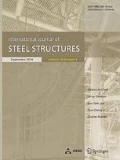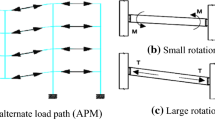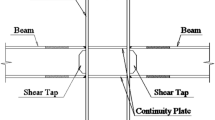Abstract
The beam-column connections are known as a fundamental component in steel moment-resisting frames. The present investigation studies the progressive collapse behavior of four various welded types of beam-column connections including, welded unreinforced flange-welded web moment (WUF-W), reduced beam section (RBS), welded flange plate (WFP), and welded flange-weld web connection with internal diaphragms (I-W). The nonlinear analysis with suitable finite element modeling has been generated to assess the connection's performance under a column removal scenario. The load–displacement curves, fracture modes, Von-Mises stresses, and other comparable theoretical results were described. The results are verified with existing experimental data. The results of the analyses showed that the studied models' overall failure occurs in the beam-column connection regions in the large rotation under the catenary action mode. The plastic strain accumulation occurred around the access hole, and the failure was initiated from these areas. Each of the investigated connections showed sufficient strength under column removal scenario. WFP connections demonstrated the best performance due to the top and bottom plates' presence and the keep away of critical stresses from the connection area. The RBS connections exhibited the weakest behavior due to absorbing excessive stresses and fast fracture and tolerating minimum vertical loads. Also, it is observed that in the designing of buildings exposed to the phenomenon of progressive collapse, the considerable axial load generated in the connections area should be considered in the design phase.














Similar content being viewed by others
References
ABAQUS. (2014). Analysis user's manual. version 6.14, ABAQUS Inc.
American Institute of Steel Construction (AISC). (2016a). Seismic provisions for structural steel buildings. ANSI/AISC 341, Chicago, IL.
American Institute of Steel Construction (AISC). (2016b). Specification for Structural Steel Buildings. ANSI/AISC 360-16, Chicago, IL.
American Institute of Steel Construction (AISC). (2016c). Prequalified connections for special and intermediate steel moment frames for seismic applications. ANSI/AISC 358, Chicago, IL.
American Society for Testing and Materials (ASTM). (2002). Standard test methods and definitions for mechanical testing of steel products. ASTM A370-02, Philadelphia, PA.
American Society of Civil Engineers (ASCE). (2016). Minimum design loads for buildings and other structures. ASCE7-16, New York.
Barmaki, S., Sheidaii, M. R., & Azizpour, O. (2020). progressive collapse resistance of bolted extended end-plate moment connections. International Journal of Steel Structures, 20(4), 1165–1179.
Brett, C., & Lu, Y. (2013). Assessment of robustness of structures: Current state of research. Frontiers of Structural and Civil Engineering, 7(4), 1–13.
Ch-Salmasi, A., & Sheidaii, M. R. (2017). Assessment of eccentrically braced frames strength against progressive collapse. International Journal of Steel Structures, 17(2), 543–551.
Ellingwood, B. R. (2006). Mitigating risk from abnormal loads and progressive collapse. Journal of Performance of Constructed Facilities, 20(4), 315–323.
Karns, J.E., Houghton, D.L., Hong, J. & Kim, J. (2009). Behaviour of varied steel frame connection types subjected to air blast, debris impact, and/or post-blast progressive collapse load conditions. In Proceedings of the 2009 structures congress, Austin, Texas.
Kiakojouri, F., De Biagi, V., Chiaia, B., & Sheidaii, M. R. (2020). Progressive collapse of framed building structures: Current knowledge and future prospects. Engineering Structures, 206, 110061.
Kiakojouri, F., & Sheidaii, M. R. (2018). Effects of finite element modeling and analysis techniques on response of steel moment-resisting frame in dynamic column removal scenarios. Asian Journal of Civil Engineering, 19(3), 295–307.
Kiakojouri, F., Sheidaii, M. R., De Biagi, V., & Chiaia, B. (2021). Progressive collapse of structures: A discussion on annotated nomenclature. Structures, 29, 1417–1423.
Lee, C., Kim, S., & Lee, K. (2010). Parallel axial-flexural hinge model for nonlinear dynamic progressive collapse analysis of welded steel moment frames. Journal of Structural Engineering, 136(2), 165–173.
Lew, H. S., Main, J. A., Robert, S. D., Sadek, F., & Chiarito, V. P. (2013). Performance of steel moment connections under a column removal scenario. I: Experiments. Journal of Structural Engineering, 139(1), 98–107.
National Institute of Science and Technology (NIST). (2005). Final report on the collapse of the world trade center towers. NCSTAR 1, US Department of Commerce, Gaithersburg, Maryland.
Li, L., Wang, W., Chen, Y., & Lu, Y. (2013). Experimental investigation of beam-to-tubular column moment connections under column removal scenario. Journal of Constructional Steel Research, 88(9), 244–255.
Li, L., Wang, W., Chen, Y., & Lu, Y. (2015). Effect of beam web bolt arrangement on catenary behaviour of moment connections. Journal of Constructional Steel Research, 104(1), 22–36.
Meng, B., Zhong, W., & Hao, J. (2018). Anti-collapse performances of steel beam-to-column assemblies with different span ratios. Journal of Constructional Steel Research, 140(1), 125–138.
Qin, X., Wang, W., Chen, Y., & Bao, Y. (2016). A special reinforcing technique to improve resistance of beam-to-tubular column connections for progressive collapse prevention. Engineering Structures, 117(1), 26–39.
Ribeiro, J., Santiago, A., Rigueiro, C., Barata, P., & Veljkovic, M. (2016). Numerical assessment of T-stub component subjected to impact loading. Engineering Structures, 106(1), 450–460.
Sadek, F., Main, J. A., Lew, H. S., & Bao, Y. (2011). Testing and analysis of steel and concrete beam-to-column assemblies under a column removal scenario. Journal of Constructional Steel Research, 137(9), 881–892.
Sadek, F., Main, J. A., Lew, H. S., & El-Tawil, S. (2013). Performance of steel moment connections under a column removal scenario. II: analysis. Journal of Structural Engineering, 139(1), 108–119.
Sadek, F., Main, JA., Lew, HS., Robert, SD., Chiarito, VP. & El-Tawil, S. (2010). An experimental and computational study of steel moment connections under a column removal scenario. NIST Technical Note 1669, National Institute of Standards and Technology, Maryland.
The U.S. General Service Administration (GSA). (2013). Alternate Path Analysis and Design Guidelines for Progressive Collapse Resistance. Washington, D.C.
Unified facility criteria (UFC). (2016). Design of building to resist progressive collapse. Department of Defense (DOD), Washington, D.C.
Wang, W., Fang, C., Qin, X., Chen, Y., & Li, L. (2016). Performance of practical beam-to-SHS column connections against progressive collapse. Engineering Structures, 106(1), 332–347.
Yang, B., & Tan, K. H. (2012a). Numerical analyses of steel beam-column joints subjected to catenary action. Journal of Constructional Steel Research, 70(3), 1–11.
Yang, B., & Tan, K. H. (2012b). Robustness of bolted-angle connections against progressive collapse: Experimental tests of beam-column joints and development of component-based models. Journal of Structural Engineering, 139(9), 1498–1514.
Yang, B., & Tan, K. H. (2013). Experimental tests of different types of bolted steel beam–column joints under a central–column–removal scenario. Engineering Structures, 54, 112–130.
Zhong, W., Meng, B., & Hao, J. (2017). Performance of different stiffness connections against progressive collapse. Journal of Constructional Steel Research, 135, 162–175.
Acknowledgements
The Authors would like to thank Dr. Foad Kiakojouri for his helpful suggestions and useful discussions. The Authors also wish to thank two anonymous reviewers for their constructive comments.
Author information
Authors and Affiliations
Corresponding author
Additional information
Publisher's Note
Springer Nature remains neutral with regard to jurisdictional claims in published maps and institutional affiliations.
Rights and permissions
About this article
Cite this article
Salmasi, A., Sheidaii, M.R. & Tariverdilo, S. Performance of Fully Restrained Welded Beam-Column Connections Subjected to Column Loss. Int J Steel Struct 21, 1370–1382 (2021). https://doi.org/10.1007/s13296-021-00505-x
Received:
Accepted:
Published:
Issue Date:
DOI: https://doi.org/10.1007/s13296-021-00505-x




